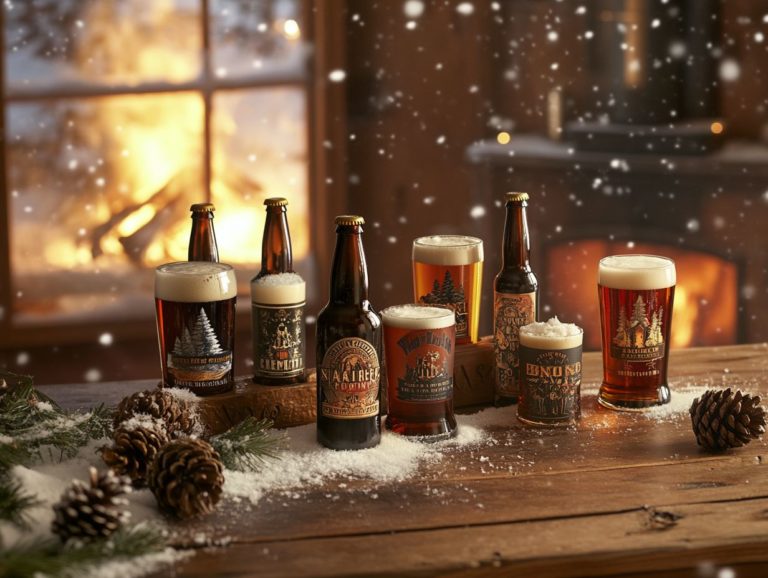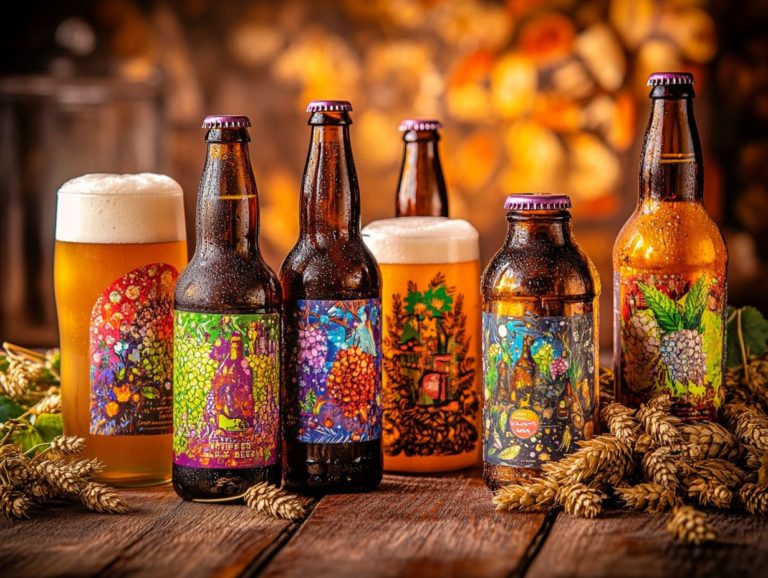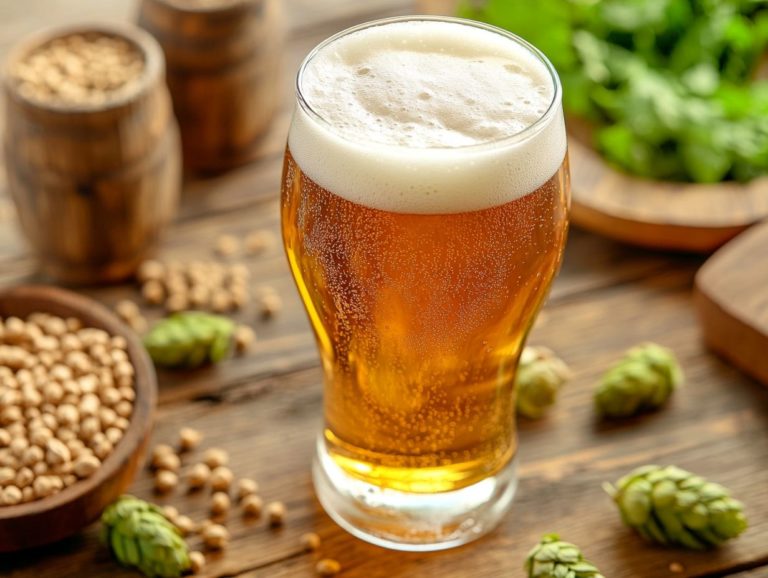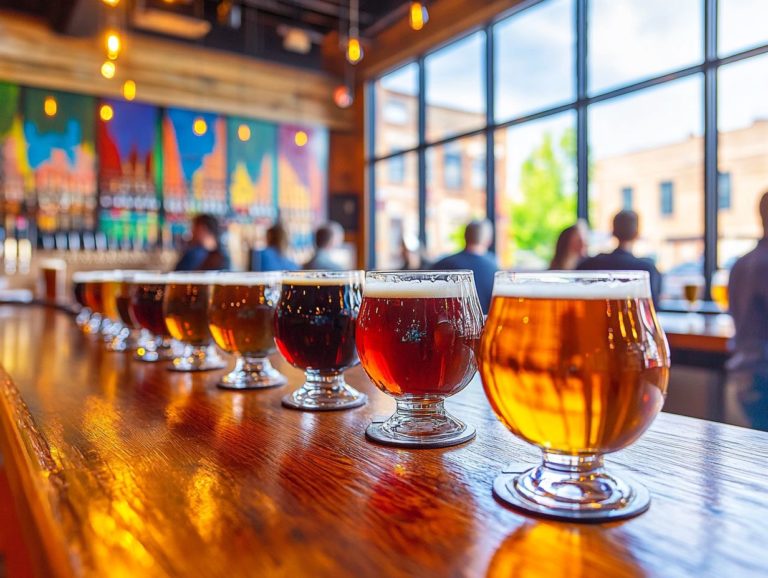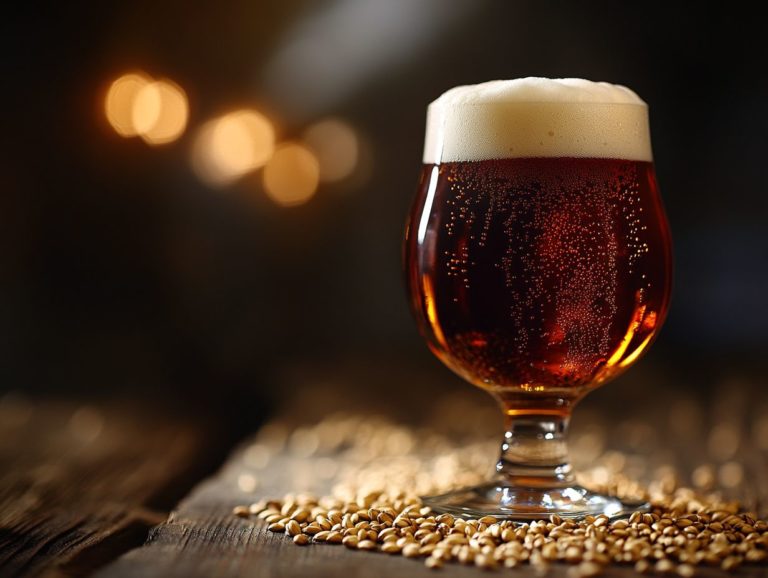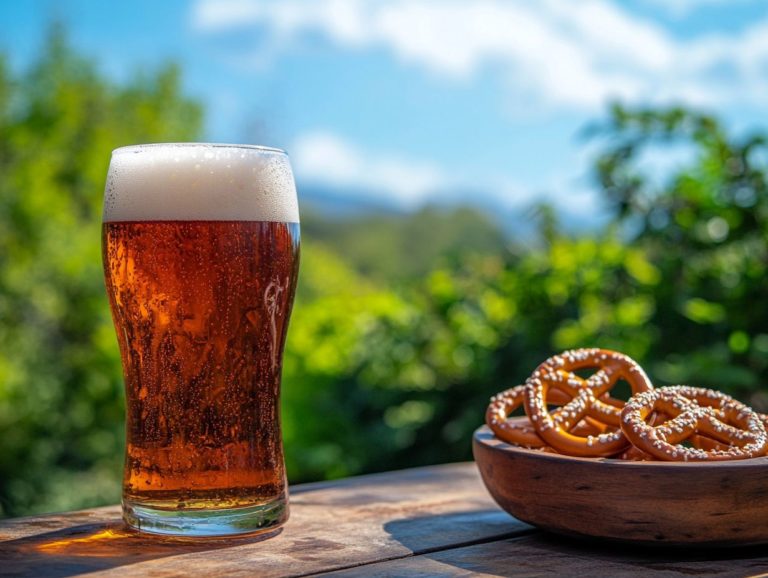Understanding the Barrel-Aging Process in Beers
Barrel-aging is a remarkable process that transforms ordinary beers into extraordinary creations through time and craftsmanship. By maturing beers in meticulously selected barrels, you can infuse complex and unique flavors and aromas that elevate your tasting experience to new heights.
In this discussion, you’ll explore the various types of barrels used, delve into the nuances of the aging process, and discover the diverse beer styles that thrive under this technique. Understanding the different barrel types, such as bourbon barrels and whiskey barrels, is crucial for mastering barrel-aging and beer aging.
You will learn about the advantages and potential pitfalls of barrel-aging, including the influence of barrel characteristics, providing valuable insights that will deepen your appreciation for this artful practice.
Contents
- Key Takeaways:
- What Is Barrel-Aging?
- What Happens During Barrel-Aging?
- What Are the Benefits of Barrel-Aging?
- Understanding the Risks of Barrel Aging
- Frequently Asked Questions
- What is the barrel-aging process in beers?
- Why is barrel-aging used in beer production?
- What types of barrels are used in the barrel-aging process?
- How long does the barrel-aging process typically take?
- What are some common flavors and aromas imparted by barrel-aging?
- Can any type of beer be barrel-aged?
Key Takeaways:
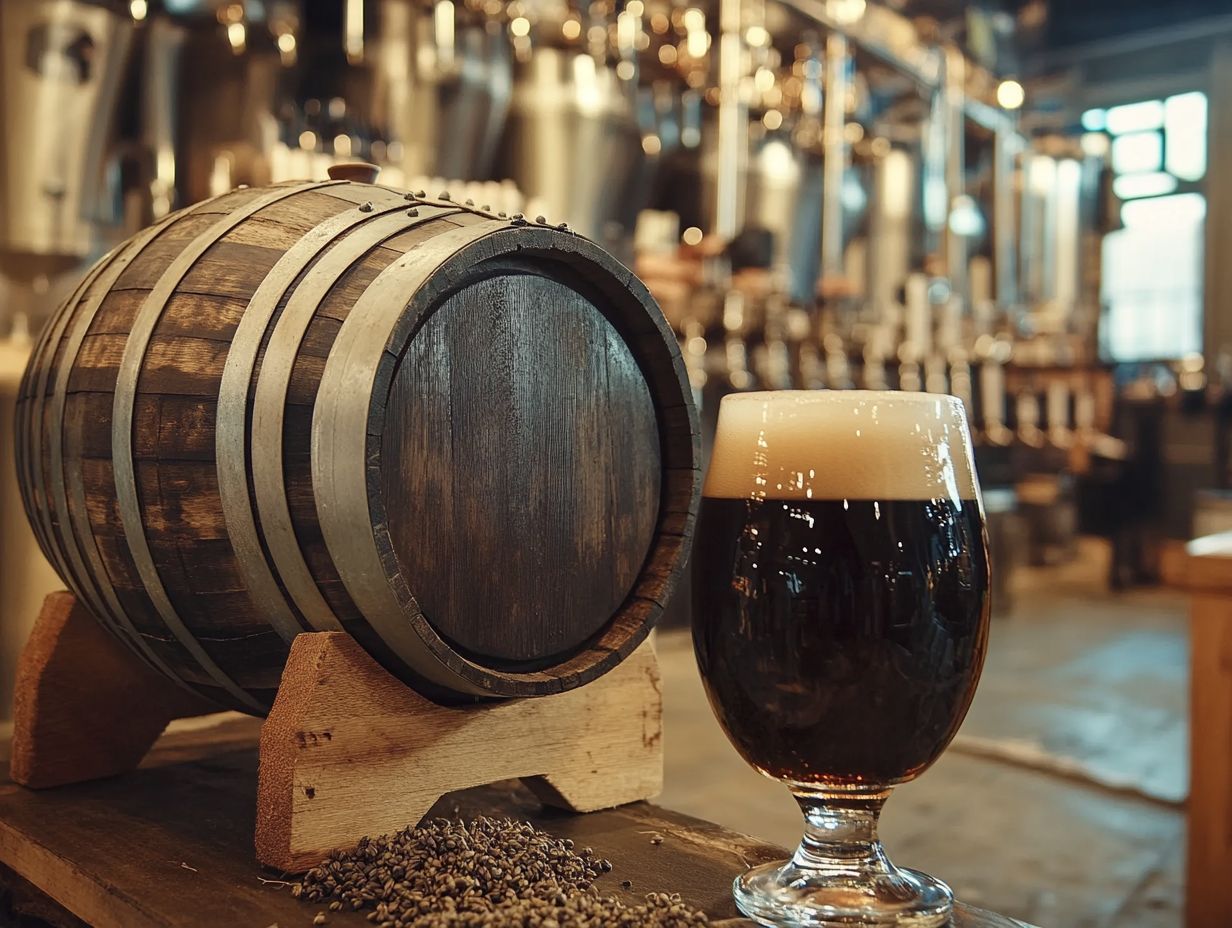
- Barrel-aging is the process of storing beer in wooden barrels to enhance its flavor, aroma, and complexity through various aging methods, including the use of spirits barrels.
- Barrels made of different types of wood, such as oak and bourbon, can infuse unique flavors and aromas into the beer, contributing to its flavor complexity.
- Barrel-aging can take anywhere from a few months to several years, depending on the type of beer and desired flavor profile, reflecting the intricacies of the aging process.
What Is Barrel-Aging?
Barrel aging is a time-honored technique in the production of various alcoholic beverages, especially beer and whiskey. The liquid matures gracefully within oak barrels. This careful process elevates the overall quality of the spirit or brew while infusing it with distinctive flavors from the wood, which may include delightful notes of vanilla, caramel, and spice.
The interaction between the liquid and the barrel often called ‘barrel magic‘ is essential for crafting the intricate flavor profile and complexity of the final product you savor. This magical process is influenced by factors like a small amount of oxygen interacting with the liquid and the specific type of wood used in the barrels.
What Types of Barrels Are Used for Aging Beers?
Several types of barrels are at your disposal for aging beers, each imparting unique characteristics and flavors to the final product. Among the most popular options are American oak barrels, often used for bourbon, and various whiskey barrels that introduce distinctive wood flavors and residual tannins, enhancing the complexity of your brew.
As a craft brewery enthusiast, you might find that experimenting with a variety of barrel types, including those previously used for wine or spirits like gin and rum, opens up a realm of innovative barrel-aged beers with captivating flavor profiles. The choice of barrels, including cognac and tequila casks, can significantly affect the final flavor profile.
The choice of barrel material significantly influences your beer’s flavor, aroma, and mouthfeel, creating a rich tapestry of tasting experiences. For example, American oak typically imparts sweeter, vanilla notes, while European oak leans toward deeper, spicier characteristics. These nuanced differences can be crucial in crafting standout beers that delight your palate. Understanding wood anatomy and barrel designs helps brewers optimize these flavor nuances.
Renowned craft breweries such as Firestone Walker and The Bruery have earned recognition for their mastery in barrel-aged beers. They demonstrate how the right barrel choice can elevate a beer s intricate flavors. Discovering these subtleties will ignite your appreciation for the craftsmanship behind each brew and embark you on an exciting journey through the diverse world of barrel aging. Breweries like Goose Island also showcase how barrel influence and cooperage can enhance the aging process.
In summary, barrel-aging is not just a technique; it s an art that transforms beers into remarkable creations. Dive deeper into this fascinating world, and you ll uncover a multitude of flavors and experiences waiting to be savored.
How Long Is the Barrel-Aging Process?
The barrel-aging process can be quite the journey, with durations varying dramatically from just a few months to several years. It all hinges on the type of beer you re working with and the flavor profile you aim to achieve. Factors like aging time and storage conditions are essential in shaping the final taste and quality of your barrel-aged beer. The process involves careful management of barrel storage and monitoring barrel integrity to ensure optimal results.
For example, if you re diving into Imperial Stouts, expect to wait longer for that rich flavor complexity to develop. On the other hand, if you prefer lighter beer styles, a shorter aging period might be your best bet to maintain that refreshing character. The choice of aging methods and barrel maturation time significantly impacts the final product.
You should also consider how environmental conditions, like temperature and humidity, play into this intricate aging dance. Higher temperatures can speed up maturation, leading to bolder flavors, while cooler conditions might slow things down, allowing for a more nuanced profile to emerge.
Consider renowned barrel-aged beers such as Goose Island’s Bourbon County Stout, which generally ages for 12 to 18 months, or Firestone Walker s Parabola, which can mature for up to a year. Brewers take great care in evaluating the characteristics of the barrels they use, including what was in them before and the levels of toast and char on the wood. This careful consideration helps determine the precise moment when the beer has reached its optimal flavor peak. Notable examples include the Bourbon County Brand Stout from Goose Island Brewery and other distinctive barrel-aged offerings from renowned breweries.
What Happens During Barrel-Aging?
Throughout the barrel-aging process, a series of vital chemical reactions and physical transformations take place, profoundly enhancing the beverage’s characteristics. One of the principal processes you ll encounter is oxidation, which helps develop new flavors as the beer mingles with the wood. This process, known as micro-oxidation, allows tiny amounts of oxygen to interact with the beer, a critical element in developing the final flavor profile of barrel-aged beer.
Evaporation also plays a significant role; as the liquid slowly diminishes in volume, the flavors within the barrel become more concentrated. This intricate dance of oxidation, evaporation, and flavor infusion creates a beverage that beautifully showcases a unique fusion of wood flavors and brewing traditions, ultimately elevating its overall appeal. The role of barrel integrity is paramount in ensuring that these processes yield the desired results.
1. Oxidation and Evaporation
Oxidation plays a crucial role in barrel aging, as small amounts of oxygen gently seep through the wood. This process leads to the development of unique flavor notes and enhances the beer’s complexity. Alongside oxidation, evaporation plays its part by causing the beer to lose a bit of its volume, which, in turn, intensifies the remaining flavors as the liquid becomes more concentrated. This interplay of oxidation and evaporation is essential for achieving those sought-after barrel characteristics and extracting vibrant flavors in the final product. Monitoring the beer aging process is crucial to achieving the desired outcome.
During maturation, the interaction between the liquid and the wood creates a harmonious blend of flavors, including delightful hints of vanilla, caramel, and spice. Regularly sampling the beer allows brewers to monitor its aging progression and adjust the time it spends in the barrel with precision.
The integrity of the barrel is critically important; any leaks or damage can lead to excessive evaporation or unwanted oxidation, both of which can adversely affect the flavor profile. Some brewers, for example, intentionally use barrels that were previously home to wine or spirits, infusing the brew with added complexity.
By expertly managing these factors, brewers can craft a distinctive and well-rounded final product that beautifully highlights the intricate balance of wood and beer flavors. The use of fermentation tanks in conjunction with barrel aging can help control these variables, ensuring a high-quality result. Dive into the world of barrel aging and experience the art and science behind every sip!
2. Flavor Infusion
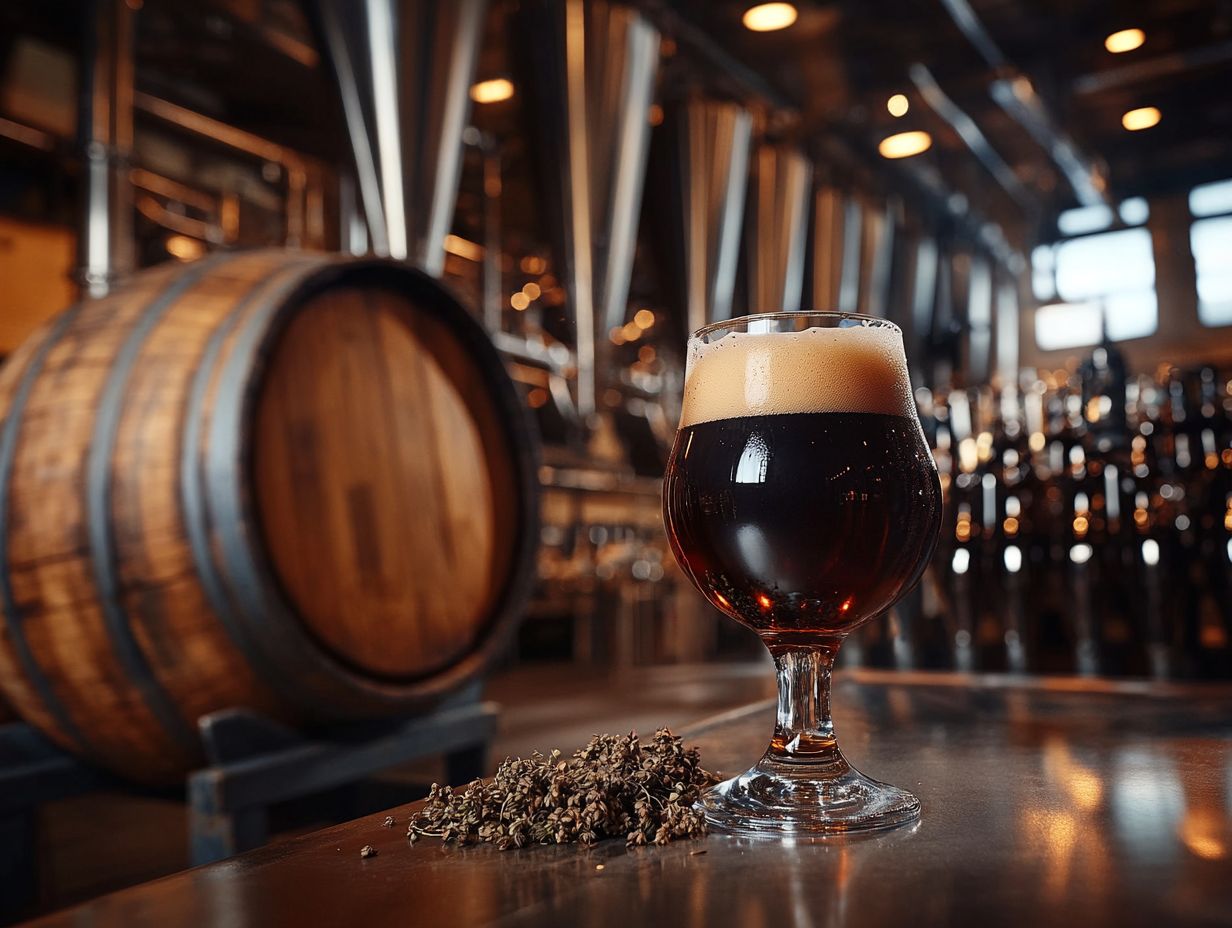
Flavor infusion is a vital aspect of barrel aging. The wood mixes with your beer to impart the distinctive flavors and aromas you crave. Different types of barrels lend a variety of wood flavors think vanilla, caramel, and spice each enhancing the overall complexity of your brew.
This infusion process empowers you to craft unique beer styles that reflect the barrel’s characteristics. Your selection of barrel types becomes a crucial element in your brewing techniques.
You may want to experiment with barrels made from a variety of woods, including oak, cherry, and even bourbon or wine casks. Each wood type offers its unique charm; for instance, oak barrels impart creamy vanilla notes while cherry wood introduces subtle hints of tart fruit.
By marrying these flavor nuances with specific beer styles, whether it s a stout or a sour ale, you can boldly innovate and push the boundaries of flavor, creating memorable experiences for beer enthusiasts.
This creative approach redefines traditional brewing methods and weaves a rich tapestry of flavors to surprise and delight consumers.
3. Fermentation
The fermentation process doesn t stop when the beer is nestled in barrels; it can continue to evolve. Wild yeast strains can make their grand entrance, introducing captivating complexity and depth of flavor as the beer interacts with the barrel.
Residual sugars and compounds in the brew engage with the wood, creating a beautiful interplay that brewers often embrace. By combining traditional brewing techniques with innovative methods, they craft distinctive barrel-aged beers that stand out.
The role of wild yeast during this phase is crucial. It enhances intricate flavor profiles and introduces delightful nuances, like funk and earthiness, that define many artisanal brews.
As the beer matures, the wood s porosity allows oxygen to mix with the liquid. This enriches its texture and aroma. The delicate dance of oxidation and wild fermentation reveals rich caramel, smooth vanilla, and complex fruit notes that develop over time. The fermentation process and environmental conditions, such as temperature and humidity, also play significant roles in this transformation.
Many brewing traditions take great pride in these transformative elements, showcasing the skill and artistry that create remarkable barrel-aged offerings.
What Types of Beers Are Typically Barrel-Aged?
Barrel-aged beers offer a remarkable array of styles, each uniquely transformed by the aging process to reveal exquisite flavors and aromas. Among the most notable are Imperial Stouts, which gain profound depth and complexity from the wood, while Porters emerge smoother and richer.
Sour beers and Belgian ales often use barrel aging, enhancing their tartness and earthy undertones. This showcases the versatility of barrel aging, elevating a wide spectrum of beer styles to new heights.
1. Stouts and Porters
Stouts and porters are some of the most sought-after styles for barrel aging, with Imperial Stouts earning acclaim for their rich and bold flavors. As these dark brews age, they soak up intricate notes from the barrel, resulting in a luxurious mouthfeel and profound depth of flavor. When conditions are just right, craft breweries produce barrel-aged versions that dazzle your palate with a stunning array of flavor profiles, perfectly catering to your appreciation for rich and robust beers.
What makes stouts and porters especially suited for this technique is their natural malt sweetness and elevated alcohol content, which harmoniously complement flavors imparted by oak barrels think vanilla, coffee, and dark chocolate. The result is a beer that thrills your palate with its heightened complexity and a velvety texture that lingers enticingly.
Examples like Bourbon County Brand Stout from Goose Island showcase these characteristics, illustrating how barrel aging can elevate the inherent qualities of these beloved styles. The Founders KBS (Kentucky Breakfast Stout) has also earned accolades for its exquisite balance of coffee and bourbon notes, perfectly demonstrating the remarkable depth and character that barrel aging can provide.
2. Sour Beers
Sour beers thrive through barrel aging, as this process unlocks a symphony of intricate flavors driven by wild yeast strains. The interaction between the beer and the barrel crafts a complex tapestry of sour, fruity, and earthy notes that tantalize your palate. Craft breweries often embrace this richness, exploring various barrels to enhance flavor profiles and create distinctive barrel-aged sour beers.
As these wild yeasts weave their magic, they bestow unique characteristics that elevate a straightforward brew into a deeply layered experience. Classic examples like Duchesse De Bourgogne and The Bruery s Terreux series exemplify how barrel aging can amplify sourness while seamlessly introducing complementary vanilla and oak flavors.
The creativity in these processes showcases the brewer’s artistry and inspires daring experimentation with different wood types and aging durations, challenging the conventions of traditional sour ales. With each batch, you embark on a fresh sensory journey, as the choice of barrel and its previous contents play a crucial role in shaping the final product.
3. Belgian Ales
Belgian Ales are renowned for their captivating flavor profiles, often elevated through barrel aging, which deepens complexity and accentuates unique characteristics. This aging process allows subtle notes of fruit, spice, and earthiness to blossom, creating a harmonious symphony of flavors that beautifully reflects both the beer and the barrel.
Craft breweries frequently blend traditional brewing techniques with innovative barrel aging practices to create exceptional Belgian-style barrel-aged beers. This delicate interplay can lead to truly delightful experiences, such as the fusion of bourbon-soaked vanilla intertwined with the signature fruity esters typical of Belgian strains.
When oak barrels previously aged with whiskey or wine are used, they introduce tannins and lactobacillus that enrich the beer’s character, imparting depth and a level of acidity that elevates the palate. Notable examples include the esteemed Goose Island s Sofie and the beloved Chimay Blue, both of which show how barrel aging can transform a classic into something extraordinary while honoring the essence of Belgian brewing traditions.
What Are the Benefits of Barrel-Aging?
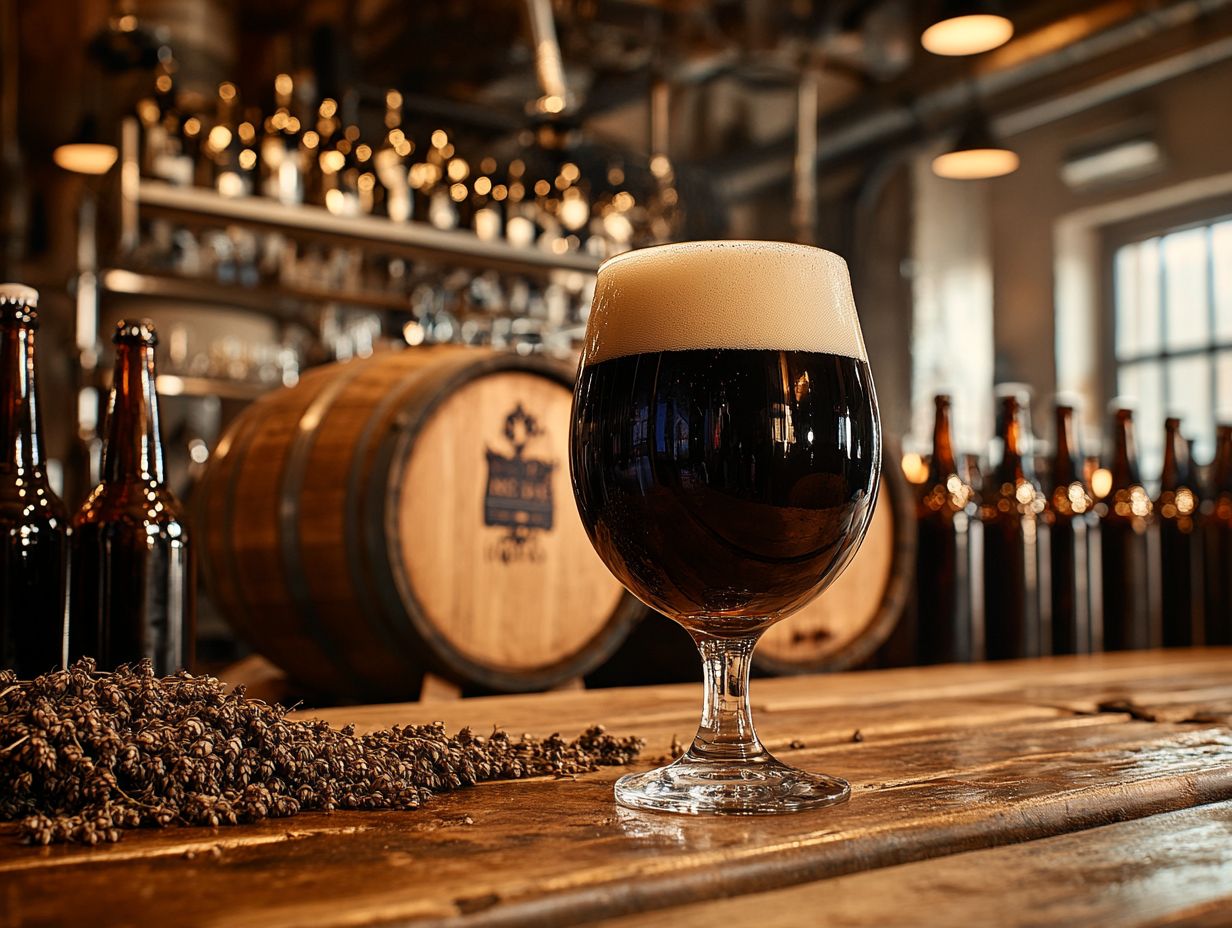
The benefits of barrel aging are remarkable, significantly enhancing both the quality and allure of the beer. This process intensifies the flavor profile and adds layers of complexity, allowing unique aromas to unfold, while also extending the shelf life by stabilizing the product.
As the beer interacts with the barrel, it absorbs a variety of flavor enhancements that elevate your drinking experience, making barrel-aged beers highly coveted by enthusiasts and collectors alike.
1. Enhanced Flavor and Complexity
One of the most significant benefits of barrel aging is the enhanced flavor and complexity it brings to your beer. This is a result of intriguing interactions between the liquid and the barrel. As your beer ages, it absorbs unique flavors from the wood think notes of vanilla, caramel, and toasted oak.
This transformation enriches the overall profile of your brew and adds depth that can vary dramatically depending on the aging time and the type of barrel used.
The type of barrel shapes the flavors significantly. For instance, whiskey barrels often impart rich, boozy notes, while wine barrels introduce fruity characteristics that enhance both the aroma and taste of your beer.
As these flavors develop, discover hints of chocolate, coffee, or even spices, elevating your drinking experience to a new level.
A classic example is the Bourbon County Brand Stout from Goose Island. This beer beautifully showcases the decadent interplay of dark malts and sweet bourbon notes, highlighting the complexities that barrel aging brings to craft beer.
2. Unique Aromas and Tastes
The unique aromas and flavors developed through barrel aging set these beers apart from their non-aged counterparts. This makes them especially enticing for craft beer aficionados like you.
As the beer mingles with the wood, it absorbs an array of aromatic compounds. This results in a captivating bouquet of scents that range from earthy and spicy to fruity and floral.
This aromatic complexity is the hallmark of barrel-aged beers. It provides a multi-sensory experience that heightens your overall enjoyment.
During the maturation process, the beer evolves, revealing layers of flavor that often highlight notes of caramel, vanilla, and even chocolate. These are influenced by the barrel type, whether it s bourbon, rum, or wine.
The warmth from the alcohol, combined with the subtle sweetness of the wood, creates a rich tapestry of flavors that invites exploration.
Noteworthy examples, such as Goose Island s Bourbon County Brand Stout and Firestone Walker s Parabola, showcase the exceptional craft and artistry of barrel aging. These beers have earned accolades for their robust profiles, ensuring enthusiasts like you keep coming back for more.
3. Increased Shelf Life
One of the remarkable benefits of barrel aging lies in the impressive shelf life it offers. This allows you to preserve your beer for extended periods without sacrificing flavor or quality.
Chemical reactions during aging enhance the beer s flavor. The protective properties of the barrel also contribute to both flavor stability and preservation.
This extended shelf life transforms barrel-aged beers into collectible treasures. It ensures they retain their intended flavor profiles over time.
The wood’s porous nature plays a pivotal role. It fosters a gradual oxidation process that softens harsh flavors while marrying them with the rich nuances imparted by the barrel.
As tannins leach from the wood, subtle notes of caramel and vanillin weave into the mix. The character of the beer evolves splendidly.
For you as a consumer, this means the joy of savoring complex and nuanced flavors over a longer duration. It often influences your purchasing decisions based on a beer’s aging potential.
For breweries, the ability to store these exceptional brews for an extended period enriches product offerings. This can lead to higher profit margins, as rare vintage releases become highly coveted in the market.
Understanding the Risks of Barrel Aging
While barrel aging presents a wealth of advantages, it also brings inherent risks that you must carefully control to ensure the quality of your final product.
Potential risks include contamination from wild yeast or bacteria, which could introduce unwelcome off-flavors into your brew. There is also the concern of over-oaking, where the wood characteristics might overshadow the beer’s intrinsic flavors.
If the barrel storage conditions aren’t optimal, it can jeopardize the aging process’s integrity. This ultimately affects the flavor stability of your beer.
1. Contamination
Contamination represents a significant risk during the barrel aging process. The introduction of wild yeast or bacteria can create off-flavors that compromise the intended profile of your beer. This risk becomes especially pronounced when barrels are reused or not properly sanitized, allowing unwanted microorganisms to flourish and disrupt the aging process. Micro-oxidation, or the slow interaction of oxygen with beer over time, can also affect flavor profiles. Remain vigilant in monitoring your barrels to minimize the chances of contamination and ensure that the final product stays true to its desired character.
As you delve into the nuances of barrel aging, recognize the delicate balance between desirable and undesirable microbial activity. While wild yeast and bacteria can impart complexity and depth to flavors, if left unchecked, they can obliterate the carefully crafted profile of your brew. This is where the fermentation process and the type of barrel you choose matter greatly.
Professional brewers often implement rigorous sanitation protocols, utilizing hot water and approved cleaning agents to cleanse barrels thoroughly before use. Conducting regular sensory evaluations and microbial testing helps assess the health of the barrel ecosystem, allowing you to address any issues before they escalate. This vigilance in monitoring and sanitation is part of the broader brewing history and brewing traditions passed down through generations of craft breweries.
Embrace these best practices to elevate your craft to new heights!
2. Off-Flavors
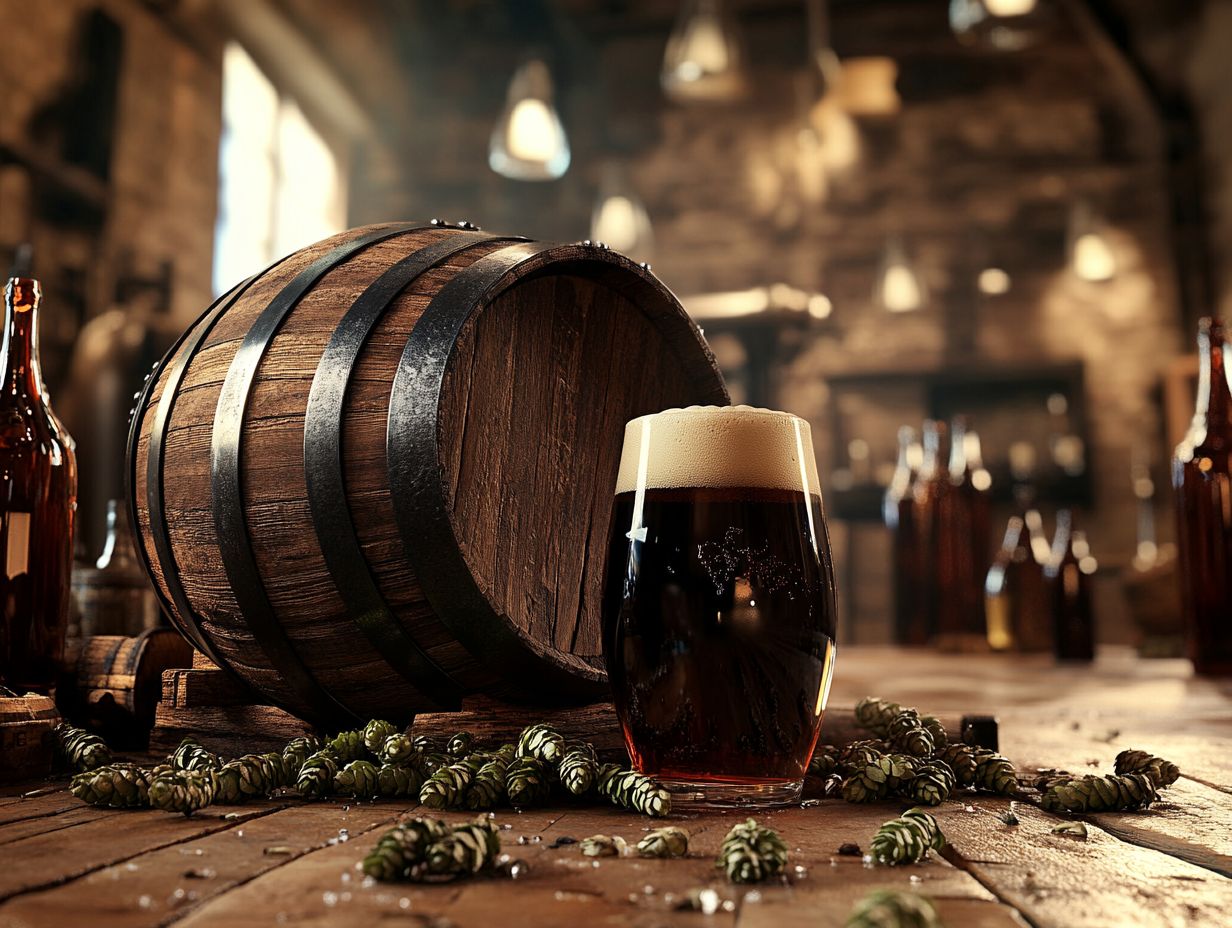
Off-flavors can emerge during the barrel aging process due to various factors, such as contamination, poor barrel selection, or an excessive aging duration. Factors like barrel integrity and the chemical reactions occurring within the barrel can introduce unwanted flavors, overshadowing the intrinsic qualities of the beer and diminishing your overall drinking experience.
To mitigate this risk, be meticulous in your barrel selection and aging practices, closely monitoring flavor development throughout the maturation process. Choosing specific oak species and ensuring proper barrel storage can greatly influence the final outcome.
Contamination from undesirable microorganisms can introduce sour notes or other off-tastes that detract from the original flavor profile intended by you. The choice of barrel is equally important; different materials can interact with the beer in unique ways, sometimes imparting flavors that are neither desirable nor anticipated. Aging for too long can lead to a loss of intended freshness, leaving your beers tasting stale.
Understanding the nuances of barrel interaction and the specific barrel characteristics can help predict and manage these risks. By conducting regular tastings and assessments, identify these issues early and make necessary adjustments to preserve your product s intended character and appeal.
The use of spirits barrels, such as whiskey barrels or bourbon barrels, can add unique flavors that contribute to the overall flavor complexity of the beer. Get hands-on with your barrels and discover the unique flavors they can bring to your beer!
3. Over-Oaking
Over-oaking is a prevalent risk when it comes to barrel aging. The bold wood flavors from the barrel can easily overpower the inherent characteristics of your beer, creating an imbalance in flavor. This often happens when beers are aged too long in barrels that impart strong wood notes, such as American Oak. The result is a final product that tastes more like the barrel than the beer itself. This phenomenon is often referred to as the whiskey character of the beer.
It s crucial for you as a brewer to find that delicate balance between achieving the desired flavors and sidestepping the pitfalls of over-oaking. Knowledge of barrel designs and wood anatomy can aid in making informed decisions during the aging process.
To prevent the wood notes from taking over, you can employ several strategies throughout the aging process. One effective approach is to closely monitor aging times, shortening them if necessary to preserve the unique profile of your beer. By tasting at various intervals, you can pinpoint the exact moment when the flavor hits that sweet spot, ensuring it remains true to its intended character.
Understanding the role of residual tannins natural compounds that can add astringency and depth to flavors and how they contribute to flavor extraction can be beneficial.
Using barrels that have previously aged other beverages or blending beers from different barrels can help temper the intensity of the wood flavors. This practice allows your beer’s original qualities to shine through and flourish. This approach is often referred to as creating the “magic of barrels” or barrel magic, where the interaction of different elements results in a unique final product.
Frequently Asked Questions
What is the barrel-aging process in beers?
The barrel-aging process in beers involves storing the beer in wooden barrels, typically made of oak. This method imparts unique flavors and aromas to the beer. This process can occur in a variety of oak barrels, including those that previously held wines, spirits, or other alcoholic beverages. Each type of barrel contributes unique flavors to the final product.
Why is barrel-aging used in beer production?
Barrel-aging is used in beer production to add complexity and depth to the flavor profile. It allows for the incorporation of unique flavors from the barrel, such as vanilla, caramel, and oak, into the beer. This practice is a significant aspect of beer production and contributes to the overall flavor notes and flavor enhancements of the brew.
What types of barrels are used in the barrel-aging process?
The most commonly used barrels in the barrel-aging process are oak barrels. They are porous and allow for the ideal amount of oxygen to interact with the beer. Other types of barrels that may be used include wine, whiskey, bourbon barrels, and other spirits barrels. Each type of barrel contributes different barrel characteristics to the aging beer.
How long does the barrel-aging process typically take?
The length of time for the barrel-aging process can vary depending on the type of beer and the desired flavor profile. Generally, it can take anywhere from a few months to a few years for the beer to fully mature and take on the desired flavors from the barrel. The aging time is critical as it influences the degree of barrel maturation and the final flavor profiles of the beer.
What are some common flavors and aromas imparted by barrel-aging?
Some common flavors and aromas imparted by barrel-aging in beers include:
- Vanilla
- Coconut
- Caramel
- Bourbon
- Oak
These flavors can enhance the overall flavor profile of the beer and add complexity to its taste. The influence of brewing techniques and the specific type of barrel used also play a role in the final outcome.
Can any type of beer be barrel-aged?
While many types of beers can benefit from the barrel-aging process, certain styles tend to work best. Beers with higher alcohol content, such as stouts and barleywines, are more commonly barrel-aged as they can better handle the strong flavors and aromas from the barrel. However, it ultimately depends on the brewer’s preference and experimentation. Popular examples include the Imperial Stout and the Bourbon County Brand Stout, known for their rich and complex flavors resulting from barrel-aging.
In conclusion, barrel aging is essential in brewing, allowing brewers to create unique and flavorful beers that stand out. Finding the right balance and understanding the aging process can lead to magnificent results.

